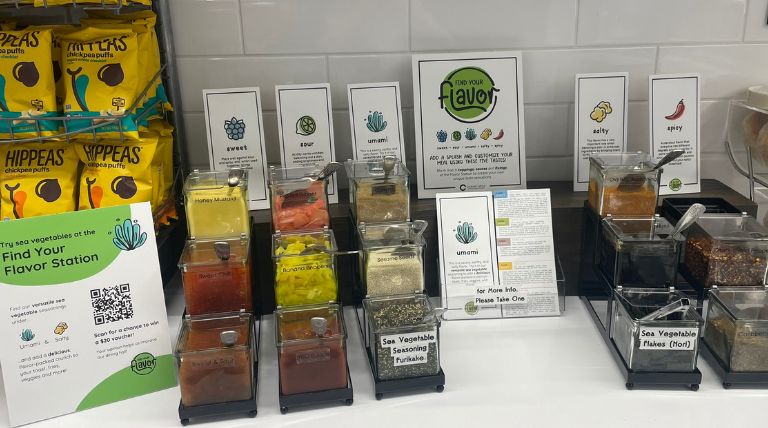RYE BROOK, N.Y., May 21, 2024—CulinArt operators are exploring the incorporation of sea vegetables into dining services offerings, mostly as seasonings presented in the Find Your Flavor station but also in entrees and salads. Sea vegetables are also figuring prominently in customer engagement activities such as Teaching Kitchens and Wellness Tabling events.
Sea vegetables are a type of aquatic food and include edible algae such as nori (often used to wrap sushi), kelp, and moss that are produced for food service in dried sheets, flakes, noodles, and snack packs, and also come frozen or fresh. CulinArt collaborated with Food for Climate League (FCL), a nonprofit working to promote climate-smart eating, on ways to introduce sea vegetables into dining operations.
To kick off the campaign, three CulinArt accounts worked directly with FCL on a research study that added two to three types of sea vegetable seasonings—furikake (a blend of dried, roasted sea vegetables, sesame seeds, salt, and sugar), wakame, and nori flakes—to their existing Find Your Flavor stations. Surveys conducted during the campaigns endeavored to determine customers’ reactions to each.
According to survey results, diners responded more positively overall to the flavor and versatility messages, though not significantly so. FCL determined that customers enjoyed the seasonings and expressed interest in eating more sea vegetables.
In day-to-day operations at three CulinArt accounts—The Archer School for Girls, in Los Angeles; Memorial Sloan-Kettering Cancer Center, in New York; and George School, in Newtown, Pa.—customers mostly added dried sea vegetable flakes to a variety of dishes including salads, Pan Asian dishes, and even mac-and-cheese. Meghan Lambert-Jackson, director of dining services at Archer School, witnessed “some of the kids occasionally using the nori pieces as a snack, kind of like the seaweed snack packs that are really popular right now.”
The campaign also gathered CulinArt associates’ perspectives on working sea vegetables into menus. While most associates had never worked with sea vegetable seasonings before, overall the CulinArt team was inspired by the trial and viewed it as an entry point for introducing sea vegetables more broadly. “Adding wakame on top of a chicken dish brought an unfamiliar item to a familiar protein,” explained Tim Gober, exec. chef at George School. “It gave the dish brightness, crunchy texture, and a savory umami note.”
CulinArt expanded the sea vegetable awareness campaign with a focused Teaching Kitchen curriculum and an interactive wellness table that invited students at George School to mix and match from five different sea vegetables atop traditional steamed rice. “Educating students on why sea vegetables are good for the planet and good for you was just Step One,” explained Ali Bernardi, VP of Marketing and Strategy for CulinArt. “From there we wanted students to explore what sea vegetables taste like and then learn how to incorporate these superfoods into their diet.”
As with all of CulinArt’s sustainability programs, education and engagement are key. “We work with our onsite teams to determine what is most important to our guests in terms of sustainability,” said Stephanie Dorfman, MS, RDN, CulinArt’s director of nutrition and wellness. “We were excited to present them with this potentially new, for some, sustainability and wellness education on sea vegetables—how to naturally add them to daily meals and why they are sustainably superior.”
Peter Klein, CulinArt’s director of culinary development, notes that the sea vegetable seasonings work well for café operations with rice or noodle bowl stations, and as condiments for virtually any other kind of menu concept. About a dozen CulinArt accounts are regularly purchasing nori flakes, furikake, and wakame for those applications, while others are buying wakame for use in salads.
For a recent company summit, CulinArt and FCL jointly produced a 90-second video that highlighted some of the high points of the campaign and showcased sea vegetables in recipe production and as part of a marketing/awareness campaign.
Click here to view the video, here for the FCL research study, and here for more information on Food for Climate League and its efforts to promote aquatic foods.


